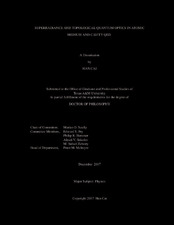| dc.description.abstract | In this dissertation we focused on two topics: 1. atomic cooperative effect, including superradiance, subradiance and collective Lamb shift in an atomic ensemble; 2. novel topological effect in quantum optics system, such as Haldane model, synthetic magnetic field in superradiance lattice and synthetic spin-orbit interaction in Fock-state lattices.
In the first part, we start from the Dicke state, an N-particle atomic ensemble excited by a single photon. Due to the interaction of the atoms with a continuum of vacuum modes, the Dicke state has a larger decay rate compared with an isolated atom, termed the single photon superradiance. In the “opposite” case, the single-photon subradiance state does not decay because of the destructive interference of the atomic transitions. We study the protection of subradiant states by the symmetry of the atomic distributions in the Dicke limit, in which collective Lamb shifts cannot be neglected. We find that antisymmetric states are subradiant states for distributions with reflection symmetry. Continuous symmetry can also be used to achieve subradiance in an extended ensemble. This study is relevant to the problem of robust quantum memory with long storage time and fast readout.
In the second part, we start from introducing the concepts, methods, and models from quantum optics or condensed matter physics. They include the timed-Dicke states, electromagnetically induced transparency, coupled wave equations, tight-binding model, band theory, Floquet theory, superradiance lattice, integer quantum Hall effect, Haldane model, etc.. Based upon these tools, we study three topological quantum optics systems: (i) a Haldane model with in situ tunable topological properties in a two-dimensional momentumspace superradiance lattice composed of timed Dicke states in electromagnetically induced transparency; (ii) a spin-orbit coupled Fock-state lattice, which introduce a novel quantum operation to generate mesoscopic superposition states, e.g., the NOON states and cat states; (iii) a synthetic magnetic field created in a quasi one dimensional superradiance lattice, which is predicted to be observed in thermal vapours of alkali atoms instead of only in cold atoms (as in previous experiments). This study aims to provide a novel, highly tunable platform simulating exotic phenomena in condensed matter physics and offers a basis of topological quantum optics and novel photonic devices. | en |


